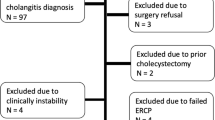Abstract
Background
We set out to review and evaluate the results of an algorithm for managing choledocholithiasis in patients undergoing laparoscopic cholecystectomy.
Methods
We performed retrospective review of patients with choledocholithiasis at the time of laparoscopic cholecystectomy (LC) between March 1993 and August 1999. All patients were operated on under the direction of one surgeon (M.E.A), following a consistent algorithm that relies primarily on laparoscopic transcystic common bile duct exploration (TCCBDE) but uses laparoscopic choledochotomy (LCD) when the duct and stones are large or if the ductal anatomy is suboptimal for TCCBDE. Intraoperative endoscopic retrograde sphincterotomy (ERS) is done if sphincterotomy is required to facilitate common bile duct exploration (CBDE). Postoperative endoscopic retrograde cholangiopancreatography (ERCP) is utilized when this fails. Preoperative ERCP is used only for high-risk patients.
Results
A total of 728 LC were performed, and there were 60 instances (8.2%) of choledocholithiasis. Primary procedures consisted of 47 TCCBDE; 37 of them required no other treatment. In five cases, the stones were flushed with no exploration. Intraoperative ERS was performed three times as the only form of duct exploration. LCD was utilized twice; one case also required intraoperative ERS, and the other had a postoperative ERCP for stent removal. One patient with small stones was observed, with no sequelae. Preoperative ERCP was done twice as the primary procedure. Of the 10 cases that were not completely cleared by TCCBDE, three had a postoperative ERCP and seven had an intraoperative ERS, one of which required a postoperative ERCP. There were three complications (6%) related to CBDE, with no long-term sequelae. There were four postoperative complications (6.7%) and no deaths. The mean number of procedures per patient was 1.12. The average postoperative hospital stay was 1.8 days (range, 0–14).
Conclusions
Choledocholithiasis can be managed safely by laparoscopic techniques, augmenting with ERCP as necessary. This protocol minimizes the number of procedures and decreases the hospital stay.
Similar content being viewed by others
References
Arregui ME, Davis CJ, Arkush AM, Nagan RF (1992) Laparoscopic cholecystectomy combined with endoscopic sphincterotomy and stone extraction or laparoscopic choledochoscopy and Electro Hydrolic Lithotripsy for management of cholelithiasis with choledocholithiasis. Surg Endosc 6: 10–15
Arregui ME, Naverrete JL, Davis CJ, Hammond JC, Barteau J (1994) The evolving role of ERCP and laparoscopic common bile duct exploration in the era of laparoscopic cholecystectomy. Int Surg 79: 188–194
Basso N, Gennaro P, Desdemona S, Materia A, Silecchia G, Fantini A, Fiocca F, Trentino P (1999) Laparoscopic cholecystectomy and intraoperative endoscopic sphincterotomy in the treatment of cholecystocholedocholithiasis. Gastrointest Endosc 50: 532–535
Berthou JC, Douard F, Charbonneau P, Moussalier K (1998) Evaluation of laparoscopic management of common bile duct stones in 220 patients. Surg Endosc 12: 16–22
Crawford DL, Phillips EH (1999) Laparoscopic common bile duct exploration. World J Surg 23: 343–349
DePaula AL, Hashiba K, Bafutto M (1994) Laparoscopic management of choledocholithiasis. Surg Endosc 8: 1399–1403
Dorman JP, Franklin ME, Glass JL (1998) Laparoscopic common bile duct exploration by choledochotomy: an effective and efficient method of treatment of choledocholithiasis. Surg Endosc 12: 926–928
Gigot JF, Navez B, Etienne J, Cambier E, Jadoul P, Kestens PJ (1997) A stratified itraoperative surgical strategy is mandatory during laparoscopic common bile duct exploration for common bile duct stones. Surg Endosc 11: 722–728
Giurgiu DI, Margulies DR, Carroll BJ, Gabbay J, Iida A, Takagi S, Fallas MJ, Phillips EH (1999) Laparoscopic common bile duct exploration: long-term outcome. Arch Surg 134: 839–844
Graham SM, Flowers JL, Scott TR, Bailey RW, Scovill WA, Zucker KA, Imbembo AL (1993) Laparoscopic cholecystectomy and common bile duct stones. Ann Surg 218: 61–67
Johnson AS, Ferrara JJ, Steinberg SM, Gassen GM, Hollier LH, Flint LM (1993) The role of endoscopic retrograde cholangiopancreatography: sphincterotomy versus common bile duct exploration as a primary technique in the management of choledocholithiasis. Am Surg 59: 78–84
Liberman MA, Phillips EH, Carroll BJ, Fallas MJ, Rosenthal R, Hiatt J (1996) Cost-effective management of complicated choledocholithiasis: laparoscopic transcystic duct exploration or endoscopic sphinterotomy. J Am Coll Surg 182: 488–494
Martin IJ, Bailey IS, Rhodes M, O’Rourke N, Nathanson L, Fielding G (1998) Towards T-tube free laparoscopic bile duct exploration: a methodologic evolution during 300 consecutive procedures. Ann Surg 228: 29–34
Meyer C, Le JV, Rohr S, Thiry LC, Duclos B, Reimund JM, Baumann R (1999) Management of common bile duct stones in a single operation combining laparoscopic cholecystectomy and perioperative sphincterotomy. Surg Endosc 13: 874–877
Ng T, Amaral JF (1999) Timing of endoscopic retrograde cholangiopancreatography and laparoscopic cholecystectomy in the treatment of choledocholithiasis. J. Laparendosc Surg 9: 31–37
Paganini AM, Lezoche E (1998) Follow-up of 161 unselected consecutive patients treated laparoscopically for common bile duct stones. Surg Endosc 12: 23–29
Petelin JB (1993) Treatment of choledocholithiasis: laparoscopic approach to common duct pathology. Am J Surg 165: 487–491
Petelin JB (1999) Laparoscopic common bile duct exploration: transcystic duct approach. In: Scott-Connor CEH (ed) The SAGES manual: fundamentals of laparoscopy and GI endoscopy. Springer, New York Berlin Heidelberg, pp 167–177
Phillips EH, Carroll BJ, Pearlstein AR, Daykhovsky L, Fallas MJ (1993) Laparoscopic choledochoscopy and extraction of common bile duct stones. World J Surg 17: 22–28
Thompson DM, Arregui ME, Tetik C, Madden MT, Wegener M (1998) A comparison of laparoscopic ultrasound with digital fluorocholangiography for detecting choledocholithiasis during laparoscopic cholecystectomy. Surg Endosc 12: 929–932
Author information
Authors and Affiliations
Additional information
Online publication: 13 March 2001
Rights and permissions
About this article
Cite this article
Lilly, M.C., Arregui, M.E. A balanced approach to choledocholithiasis. Surg Endosc 15, 467–472 (2001). https://doi.org/10.1007/s004640080020
Received:
Accepted:
Published:
Issue Date:
DOI: https://doi.org/10.1007/s004640080020




